BMA777-Xikron's Expansion in China: An International HRM Analysis
VerifiedAdded on 2023/06/12
|12
|3139
|358
Case Study
AI Summary
This case study analyzes Xikron, a US-based company, and its foreign direct investment in China to expand its retail stores. It explores the economic impacts such as increased foreign direct investment, expenditure, local market competition, technology transfer, and tax income. The analysis also cover...
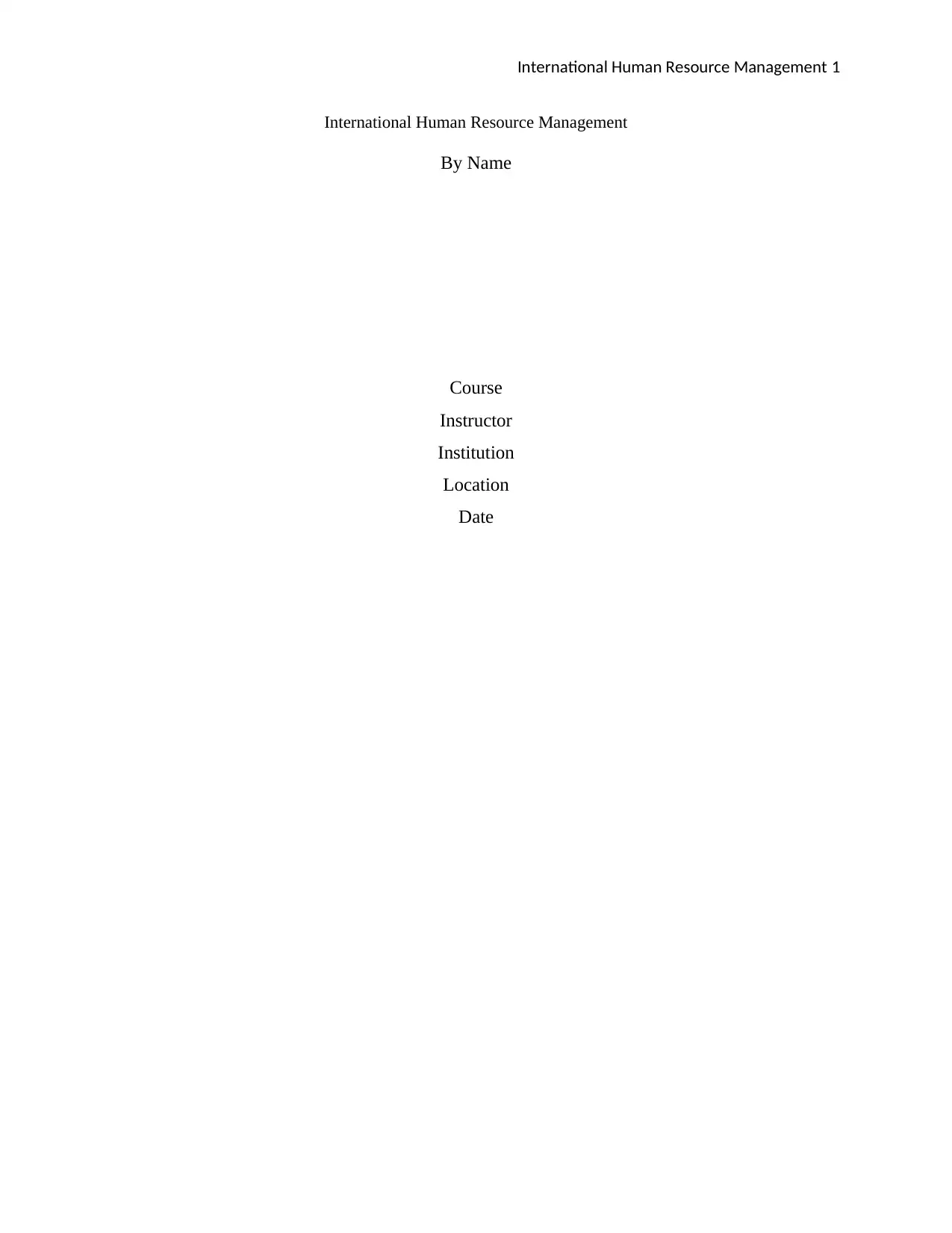
International Human Resource Management 1
International Human Resource Management
By Name
Course
Instructor
Institution
Location
Date
International Human Resource Management
By Name
Course
Instructor
Institution
Location
Date
Paraphrase This Document
Need a fresh take? Get an instant paraphrase of this document with our AI Paraphraser

International Human Resource Management 2
Introduction
The literature is about a foreign investment of a US based company, Xikron, in China with an
aim of increasing its retail store's number. The company plans to resource there managerial
employees from the United States which will subject them to more responsibilities in order
meet the company objective of expanding the business1.
Discussion
The investment project in China is accompanied by the following economic, political and social
impacts
Economic factors effects
The following are some of the economic factors effects that are achieved from Xikron’s store in
China:
Foreign direct investment
Over the past years, China has existed as a key recipient of a good destination to foreign direct
investment which accounts for 27% of the production added value, 4.1% of revenue from
national tax and foreign trade being at 58%. China has hosted investments from about 190
countries from the world nations including 450 of the world’s 500 fortune companies. Most
conducted surveys reveal that a high number of companies investing in China originates from
the US with an intention of serving the domestic market of China but no exports are being
taken back to the states of America. This eventually increases the foreign direct investment
quantity in China.
Increased expenditure
1 Scullion, Hugh. "International human resource management." (2010).
Taylor, Sully, Schon Beechler, and Nancy Napier. "Toward an integrative model of strategic
international human resource management." Academy of Management review 21, no. 4 (2015):
959-985.
Torrington, Derek. International human resource management: Think globally, act locally.
Prentice Hall, 2010.
Introduction
The literature is about a foreign investment of a US based company, Xikron, in China with an
aim of increasing its retail store's number. The company plans to resource there managerial
employees from the United States which will subject them to more responsibilities in order
meet the company objective of expanding the business1.
Discussion
The investment project in China is accompanied by the following economic, political and social
impacts
Economic factors effects
The following are some of the economic factors effects that are achieved from Xikron’s store in
China:
Foreign direct investment
Over the past years, China has existed as a key recipient of a good destination to foreign direct
investment which accounts for 27% of the production added value, 4.1% of revenue from
national tax and foreign trade being at 58%. China has hosted investments from about 190
countries from the world nations including 450 of the world’s 500 fortune companies. Most
conducted surveys reveal that a high number of companies investing in China originates from
the US with an intention of serving the domestic market of China but no exports are being
taken back to the states of America. This eventually increases the foreign direct investment
quantity in China.
Increased expenditure
1 Scullion, Hugh. "International human resource management." (2010).
Taylor, Sully, Schon Beechler, and Nancy Napier. "Toward an integrative model of strategic
international human resource management." Academy of Management review 21, no. 4 (2015):
959-985.
Torrington, Derek. International human resource management: Think globally, act locally.
Prentice Hall, 2010.
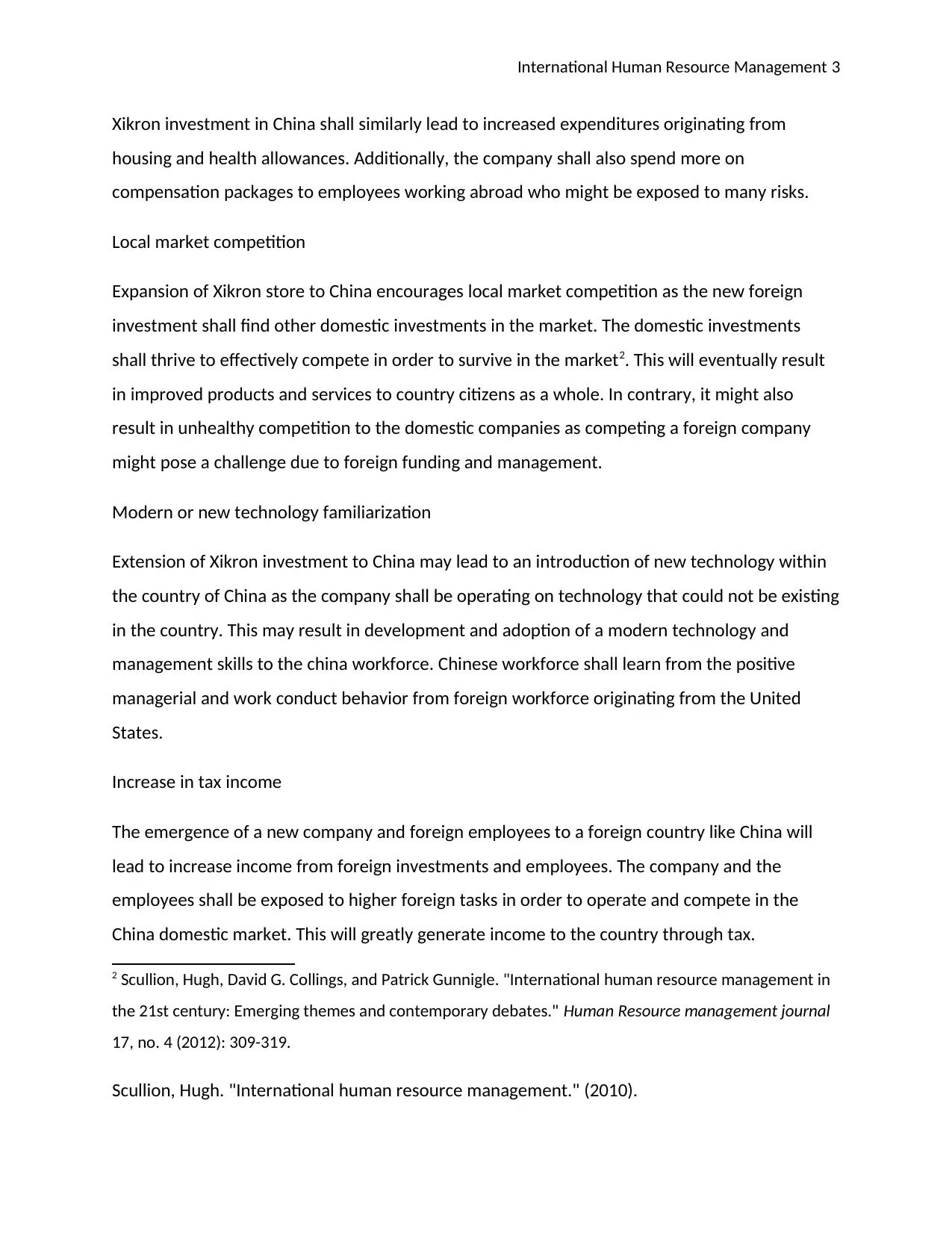
International Human Resource Management 3
Xikron investment in China shall similarly lead to increased expenditures originating from
housing and health allowances. Additionally, the company shall also spend more on
compensation packages to employees working abroad who might be exposed to many risks.
Local market competition
Expansion of Xikron store to China encourages local market competition as the new foreign
investment shall find other domestic investments in the market. The domestic investments
shall thrive to effectively compete in order to survive in the market2. This will eventually result
in improved products and services to country citizens as a whole. In contrary, it might also
result in unhealthy competition to the domestic companies as competing a foreign company
might pose a challenge due to foreign funding and management.
Modern or new technology familiarization
Extension of Xikron investment to China may lead to an introduction of new technology within
the country of China as the company shall be operating on technology that could not be existing
in the country. This may result in development and adoption of a modern technology and
management skills to the china workforce. Chinese workforce shall learn from the positive
managerial and work conduct behavior from foreign workforce originating from the United
States.
Increase in tax income
The emergence of a new company and foreign employees to a foreign country like China will
lead to increase income from foreign investments and employees. The company and the
employees shall be exposed to higher foreign tasks in order to operate and compete in the
China domestic market. This will greatly generate income to the country through tax.
2 Scullion, Hugh, David G. Collings, and Patrick Gunnigle. "International human resource management in
the 21st century: Emerging themes and contemporary debates." Human Resource management journal
17, no. 4 (2012): 309-319.
Scullion, Hugh. "International human resource management." (2010).
Xikron investment in China shall similarly lead to increased expenditures originating from
housing and health allowances. Additionally, the company shall also spend more on
compensation packages to employees working abroad who might be exposed to many risks.
Local market competition
Expansion of Xikron store to China encourages local market competition as the new foreign
investment shall find other domestic investments in the market. The domestic investments
shall thrive to effectively compete in order to survive in the market2. This will eventually result
in improved products and services to country citizens as a whole. In contrary, it might also
result in unhealthy competition to the domestic companies as competing a foreign company
might pose a challenge due to foreign funding and management.
Modern or new technology familiarization
Extension of Xikron investment to China may lead to an introduction of new technology within
the country of China as the company shall be operating on technology that could not be existing
in the country. This may result in development and adoption of a modern technology and
management skills to the china workforce. Chinese workforce shall learn from the positive
managerial and work conduct behavior from foreign workforce originating from the United
States.
Increase in tax income
The emergence of a new company and foreign employees to a foreign country like China will
lead to increase income from foreign investments and employees. The company and the
employees shall be exposed to higher foreign tasks in order to operate and compete in the
China domestic market. This will greatly generate income to the country through tax.
2 Scullion, Hugh, David G. Collings, and Patrick Gunnigle. "International human resource management in
the 21st century: Emerging themes and contemporary debates." Human Resource management journal
17, no. 4 (2012): 309-319.
Scullion, Hugh. "International human resource management." (2010).
⊘ This is a preview!⊘
Do you want full access?
Subscribe today to unlock all pages.

Trusted by 1+ million students worldwide
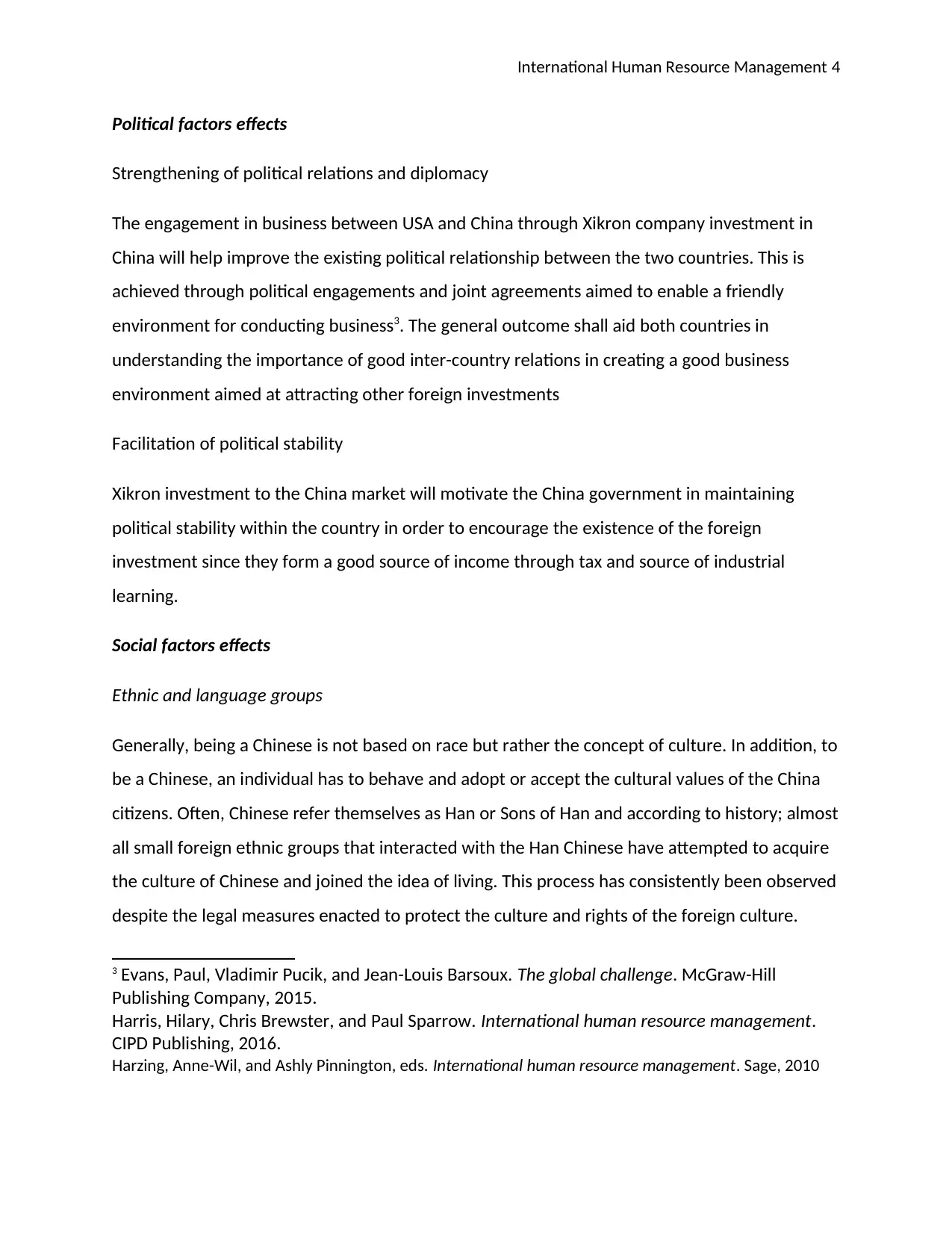
International Human Resource Management 4
Political factors effects
Strengthening of political relations and diplomacy
The engagement in business between USA and China through Xikron company investment in
China will help improve the existing political relationship between the two countries. This is
achieved through political engagements and joint agreements aimed to enable a friendly
environment for conducting business3. The general outcome shall aid both countries in
understanding the importance of good inter-country relations in creating a good business
environment aimed at attracting other foreign investments
Facilitation of political stability
Xikron investment to the China market will motivate the China government in maintaining
political stability within the country in order to encourage the existence of the foreign
investment since they form a good source of income through tax and source of industrial
learning.
Social factors effects
Ethnic and language groups
Generally, being a Chinese is not based on race but rather the concept of culture. In addition, to
be a Chinese, an individual has to behave and adopt or accept the cultural values of the China
citizens. Often, Chinese refer themselves as Han or Sons of Han and according to history; almost
all small foreign ethnic groups that interacted with the Han Chinese have attempted to acquire
the culture of Chinese and joined the idea of living. This process has consistently been observed
despite the legal measures enacted to protect the culture and rights of the foreign culture.
3 Evans, Paul, Vladimir Pucik, and Jean-Louis Barsoux. The global challenge. McGraw-Hill
Publishing Company, 2015.
Harris, Hilary, Chris Brewster, and Paul Sparrow. International human resource management.
CIPD Publishing, 2016.
Harzing, Anne-Wil, and Ashly Pinnington, eds. International human resource management. Sage, 2010
Political factors effects
Strengthening of political relations and diplomacy
The engagement in business between USA and China through Xikron company investment in
China will help improve the existing political relationship between the two countries. This is
achieved through political engagements and joint agreements aimed to enable a friendly
environment for conducting business3. The general outcome shall aid both countries in
understanding the importance of good inter-country relations in creating a good business
environment aimed at attracting other foreign investments
Facilitation of political stability
Xikron investment to the China market will motivate the China government in maintaining
political stability within the country in order to encourage the existence of the foreign
investment since they form a good source of income through tax and source of industrial
learning.
Social factors effects
Ethnic and language groups
Generally, being a Chinese is not based on race but rather the concept of culture. In addition, to
be a Chinese, an individual has to behave and adopt or accept the cultural values of the China
citizens. Often, Chinese refer themselves as Han or Sons of Han and according to history; almost
all small foreign ethnic groups that interacted with the Han Chinese have attempted to acquire
the culture of Chinese and joined the idea of living. This process has consistently been observed
despite the legal measures enacted to protect the culture and rights of the foreign culture.
3 Evans, Paul, Vladimir Pucik, and Jean-Louis Barsoux. The global challenge. McGraw-Hill
Publishing Company, 2015.
Harris, Hilary, Chris Brewster, and Paul Sparrow. International human resource management.
CIPD Publishing, 2016.
Harzing, Anne-Wil, and Ashly Pinnington, eds. International human resource management. Sage, 2010
Paraphrase This Document
Need a fresh take? Get an instant paraphrase of this document with our AI Paraphraser
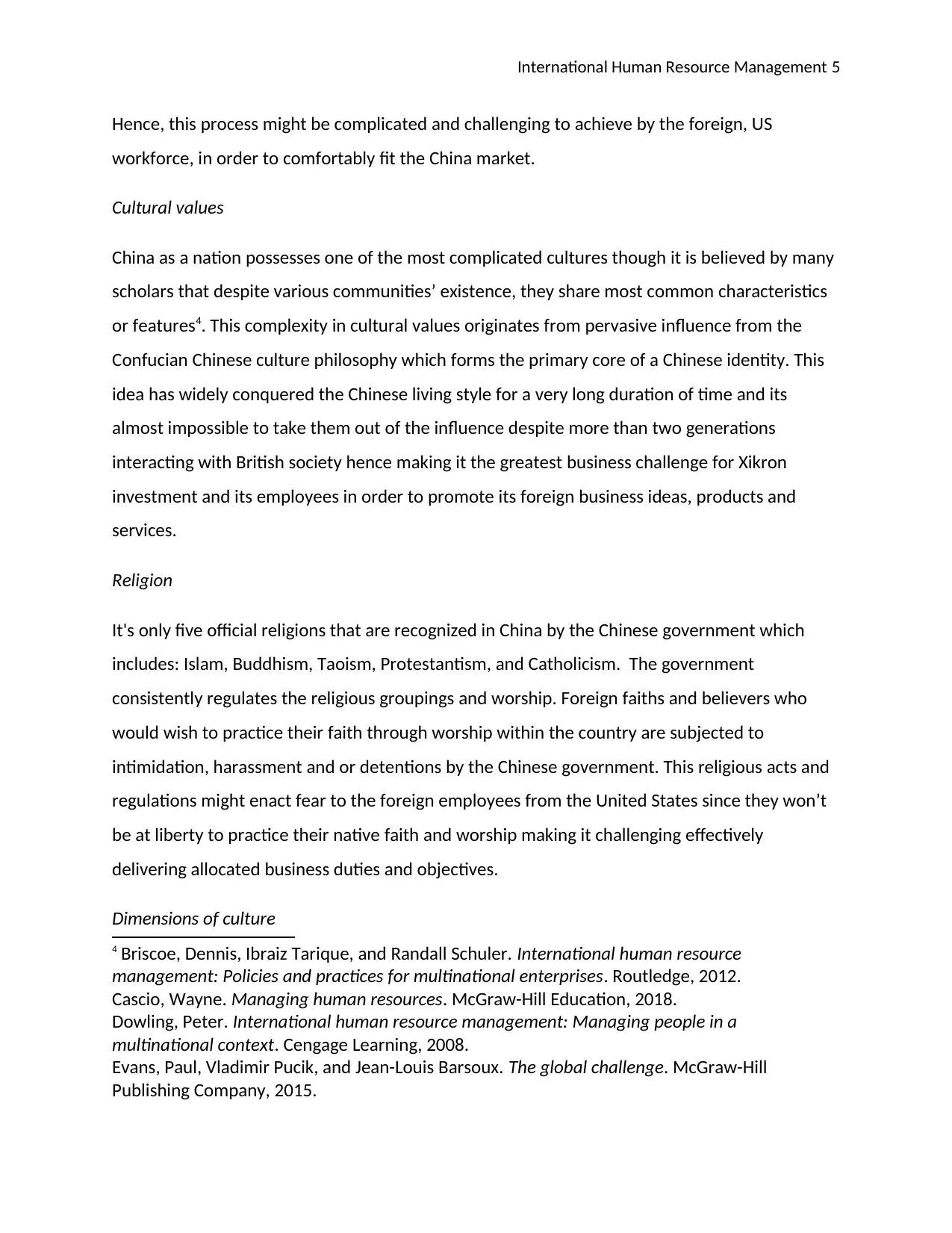
International Human Resource Management 5
Hence, this process might be complicated and challenging to achieve by the foreign, US
workforce, in order to comfortably fit the China market.
Cultural values
China as a nation possesses one of the most complicated cultures though it is believed by many
scholars that despite various communities’ existence, they share most common characteristics
or features4. This complexity in cultural values originates from pervasive influence from the
Confucian Chinese culture philosophy which forms the primary core of a Chinese identity. This
idea has widely conquered the Chinese living style for a very long duration of time and its
almost impossible to take them out of the influence despite more than two generations
interacting with British society hence making it the greatest business challenge for Xikron
investment and its employees in order to promote its foreign business ideas, products and
services.
Religion
It's only five official religions that are recognized in China by the Chinese government which
includes: Islam, Buddhism, Taoism, Protestantism, and Catholicism. The government
consistently regulates the religious groupings and worship. Foreign faiths and believers who
would wish to practice their faith through worship within the country are subjected to
intimidation, harassment and or detentions by the Chinese government. This religious acts and
regulations might enact fear to the foreign employees from the United States since they won’t
be at liberty to practice their native faith and worship making it challenging effectively
delivering allocated business duties and objectives.
Dimensions of culture
4 Briscoe, Dennis, Ibraiz Tarique, and Randall Schuler. International human resource
management: Policies and practices for multinational enterprises. Routledge, 2012.
Cascio, Wayne. Managing human resources. McGraw-Hill Education, 2018.
Dowling, Peter. International human resource management: Managing people in a
multinational context. Cengage Learning, 2008.
Evans, Paul, Vladimir Pucik, and Jean-Louis Barsoux. The global challenge. McGraw-Hill
Publishing Company, 2015.
Hence, this process might be complicated and challenging to achieve by the foreign, US
workforce, in order to comfortably fit the China market.
Cultural values
China as a nation possesses one of the most complicated cultures though it is believed by many
scholars that despite various communities’ existence, they share most common characteristics
or features4. This complexity in cultural values originates from pervasive influence from the
Confucian Chinese culture philosophy which forms the primary core of a Chinese identity. This
idea has widely conquered the Chinese living style for a very long duration of time and its
almost impossible to take them out of the influence despite more than two generations
interacting with British society hence making it the greatest business challenge for Xikron
investment and its employees in order to promote its foreign business ideas, products and
services.
Religion
It's only five official religions that are recognized in China by the Chinese government which
includes: Islam, Buddhism, Taoism, Protestantism, and Catholicism. The government
consistently regulates the religious groupings and worship. Foreign faiths and believers who
would wish to practice their faith through worship within the country are subjected to
intimidation, harassment and or detentions by the Chinese government. This religious acts and
regulations might enact fear to the foreign employees from the United States since they won’t
be at liberty to practice their native faith and worship making it challenging effectively
delivering allocated business duties and objectives.
Dimensions of culture
4 Briscoe, Dennis, Ibraiz Tarique, and Randall Schuler. International human resource
management: Policies and practices for multinational enterprises. Routledge, 2012.
Cascio, Wayne. Managing human resources. McGraw-Hill Education, 2018.
Dowling, Peter. International human resource management: Managing people in a
multinational context. Cengage Learning, 2008.
Evans, Paul, Vladimir Pucik, and Jean-Louis Barsoux. The global challenge. McGraw-Hill
Publishing Company, 2015.

International Human Resource Management 6
Cultural factors are generally measured in five distinct dimensions which include: collectivism
against individualism, masculinity against feminity, avoidance of uncertainty and long-term
orientation. These are the commonly used concepts of measuring and comparing differences in
cultures between two nations or many. In relation to this, it is observed that China and US
possess very contradicting cultural ideologies under each dimension as discussed below. These
pose a significant complexity to the visiting workforce in China.
Cultural differences between China and USA
Social structure
China as a country possesses a formal and hierarchical form of social structure such that
everybody is aware of where he or she fits ion the structure and to conform to the rules within
the distinct structure. In addition, crossing into other areas is prohibited or not allowed
whereas in America the structure is way more informal and open. it is very common to witness
individuals from a different social structure or social levels socializing and sharing ideas about
each other. There exist limited lines of restriction restricting social classes. The two differences
in the social cultures between the two countries may result into challenges and problems in a
case whereby parties engaging in business or a visiting culture are not aware of the prevailing
culture in a given country5.
Confrontation and conflict
When planning to conduct a long-term business in China, it is very necessary being aware of the
mechanisms employed by Chinese in handling and approaching issues as these mechanisms
might be controversial to those applied by Americans. Chinese are highly frowned by direct
conflict or confrontation approach to handling issues.
5 Bernardin, H. John. Human resource management: An experiential approach. Irwin
Professional Pub, 2012.
Brewster, Christopher, Elizabeth Houldsworth, Paul Sparrow, and Guy Vernon. International
human resource management. Kogan Page Publishers, 2016.
Cultural factors are generally measured in five distinct dimensions which include: collectivism
against individualism, masculinity against feminity, avoidance of uncertainty and long-term
orientation. These are the commonly used concepts of measuring and comparing differences in
cultures between two nations or many. In relation to this, it is observed that China and US
possess very contradicting cultural ideologies under each dimension as discussed below. These
pose a significant complexity to the visiting workforce in China.
Cultural differences between China and USA
Social structure
China as a country possesses a formal and hierarchical form of social structure such that
everybody is aware of where he or she fits ion the structure and to conform to the rules within
the distinct structure. In addition, crossing into other areas is prohibited or not allowed
whereas in America the structure is way more informal and open. it is very common to witness
individuals from a different social structure or social levels socializing and sharing ideas about
each other. There exist limited lines of restriction restricting social classes. The two differences
in the social cultures between the two countries may result into challenges and problems in a
case whereby parties engaging in business or a visiting culture are not aware of the prevailing
culture in a given country5.
Confrontation and conflict
When planning to conduct a long-term business in China, it is very necessary being aware of the
mechanisms employed by Chinese in handling and approaching issues as these mechanisms
might be controversial to those applied by Americans. Chinese are highly frowned by direct
conflict or confrontation approach to handling issues.
5 Bernardin, H. John. Human resource management: An experiential approach. Irwin
Professional Pub, 2012.
Brewster, Christopher, Elizabeth Houldsworth, Paul Sparrow, and Guy Vernon. International
human resource management. Kogan Page Publishers, 2016.
⊘ This is a preview!⊘
Do you want full access?
Subscribe today to unlock all pages.

Trusted by 1+ million students worldwide
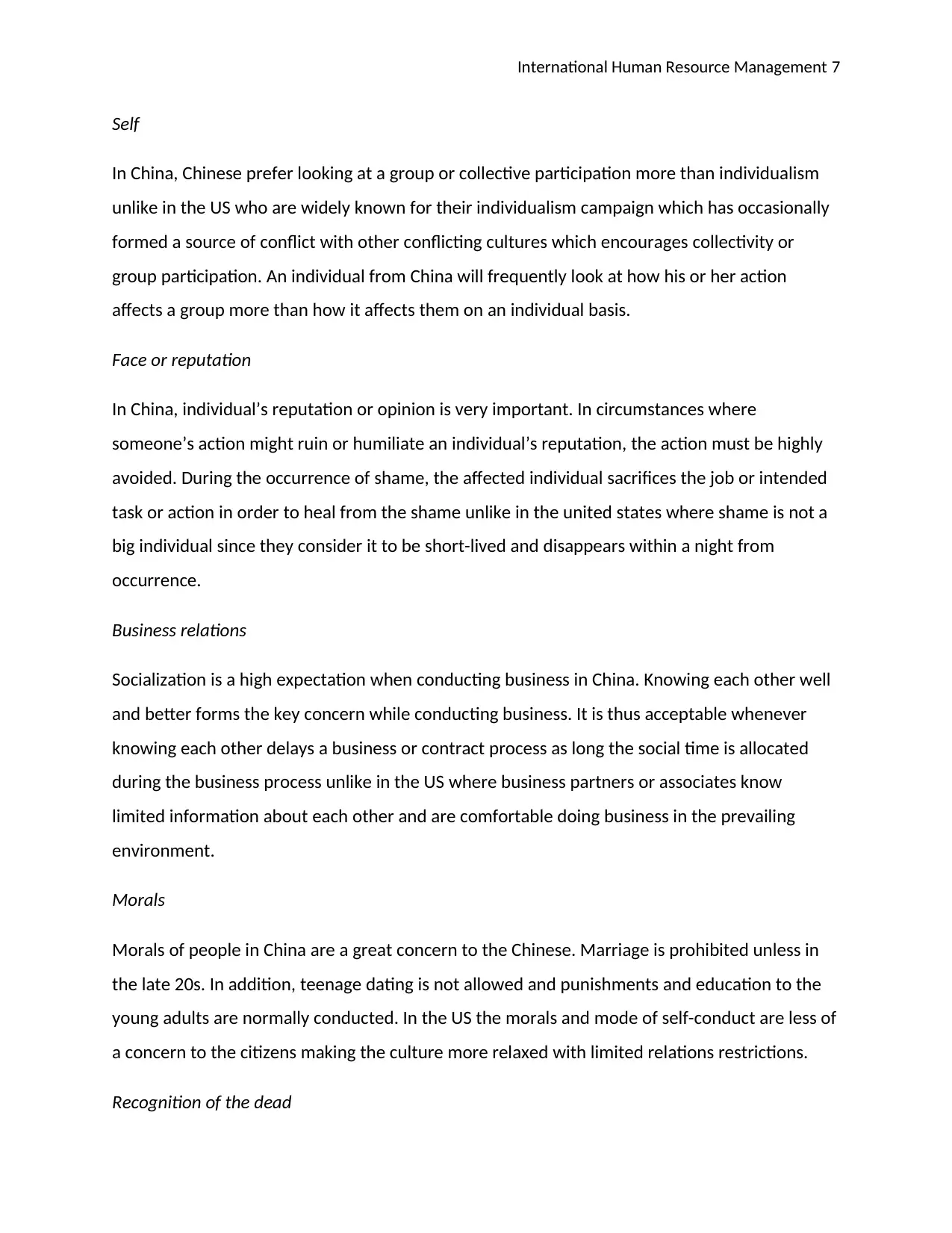
International Human Resource Management 7
Self
In China, Chinese prefer looking at a group or collective participation more than individualism
unlike in the US who are widely known for their individualism campaign which has occasionally
formed a source of conflict with other conflicting cultures which encourages collectivity or
group participation. An individual from China will frequently look at how his or her action
affects a group more than how it affects them on an individual basis.
Face or reputation
In China, individual’s reputation or opinion is very important. In circumstances where
someone’s action might ruin or humiliate an individual’s reputation, the action must be highly
avoided. During the occurrence of shame, the affected individual sacrifices the job or intended
task or action in order to heal from the shame unlike in the united states where shame is not a
big individual since they consider it to be short-lived and disappears within a night from
occurrence.
Business relations
Socialization is a high expectation when conducting business in China. Knowing each other well
and better forms the key concern while conducting business. It is thus acceptable whenever
knowing each other delays a business or contract process as long the social time is allocated
during the business process unlike in the US where business partners or associates know
limited information about each other and are comfortable doing business in the prevailing
environment.
Morals
Morals of people in China are a great concern to the Chinese. Marriage is prohibited unless in
the late 20s. In addition, teenage dating is not allowed and punishments and education to the
young adults are normally conducted. In the US the morals and mode of self-conduct are less of
a concern to the citizens making the culture more relaxed with limited relations restrictions.
Recognition of the dead
Self
In China, Chinese prefer looking at a group or collective participation more than individualism
unlike in the US who are widely known for their individualism campaign which has occasionally
formed a source of conflict with other conflicting cultures which encourages collectivity or
group participation. An individual from China will frequently look at how his or her action
affects a group more than how it affects them on an individual basis.
Face or reputation
In China, individual’s reputation or opinion is very important. In circumstances where
someone’s action might ruin or humiliate an individual’s reputation, the action must be highly
avoided. During the occurrence of shame, the affected individual sacrifices the job or intended
task or action in order to heal from the shame unlike in the united states where shame is not a
big individual since they consider it to be short-lived and disappears within a night from
occurrence.
Business relations
Socialization is a high expectation when conducting business in China. Knowing each other well
and better forms the key concern while conducting business. It is thus acceptable whenever
knowing each other delays a business or contract process as long the social time is allocated
during the business process unlike in the US where business partners or associates know
limited information about each other and are comfortable doing business in the prevailing
environment.
Morals
Morals of people in China are a great concern to the Chinese. Marriage is prohibited unless in
the late 20s. In addition, teenage dating is not allowed and punishments and education to the
young adults are normally conducted. In the US the morals and mode of self-conduct are less of
a concern to the citizens making the culture more relaxed with limited relations restrictions.
Recognition of the dead
Paraphrase This Document
Need a fresh take? Get an instant paraphrase of this document with our AI Paraphraser
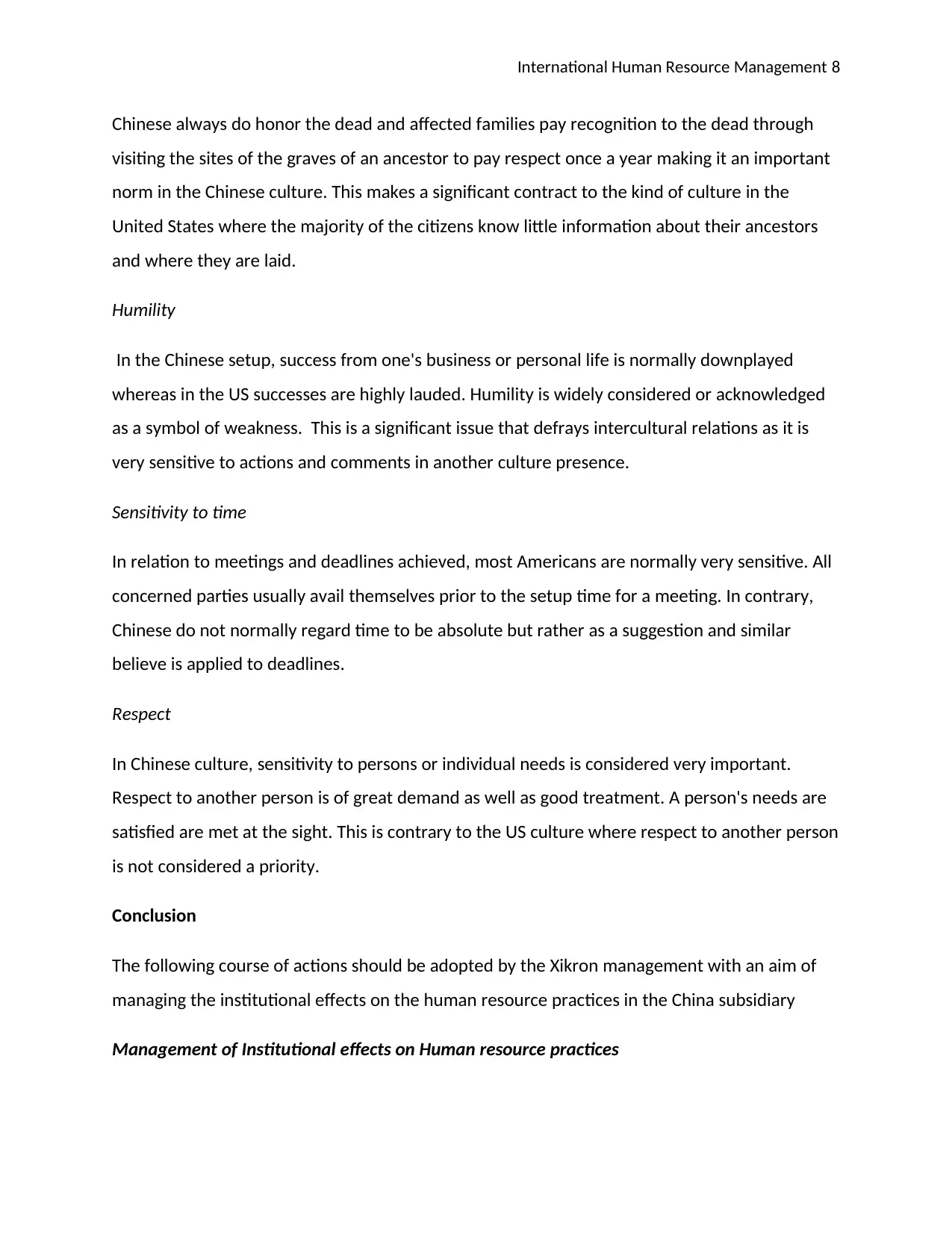
International Human Resource Management 8
Chinese always do honor the dead and affected families pay recognition to the dead through
visiting the sites of the graves of an ancestor to pay respect once a year making it an important
norm in the Chinese culture. This makes a significant contract to the kind of culture in the
United States where the majority of the citizens know little information about their ancestors
and where they are laid.
Humility
In the Chinese setup, success from one's business or personal life is normally downplayed
whereas in the US successes are highly lauded. Humility is widely considered or acknowledged
as a symbol of weakness. This is a significant issue that defrays intercultural relations as it is
very sensitive to actions and comments in another culture presence.
Sensitivity to time
In relation to meetings and deadlines achieved, most Americans are normally very sensitive. All
concerned parties usually avail themselves prior to the setup time for a meeting. In contrary,
Chinese do not normally regard time to be absolute but rather as a suggestion and similar
believe is applied to deadlines.
Respect
In Chinese culture, sensitivity to persons or individual needs is considered very important.
Respect to another person is of great demand as well as good treatment. A person's needs are
satisfied are met at the sight. This is contrary to the US culture where respect to another person
is not considered a priority.
Conclusion
The following course of actions should be adopted by the Xikron management with an aim of
managing the institutional effects on the human resource practices in the China subsidiary
Management of Institutional effects on Human resource practices
Chinese always do honor the dead and affected families pay recognition to the dead through
visiting the sites of the graves of an ancestor to pay respect once a year making it an important
norm in the Chinese culture. This makes a significant contract to the kind of culture in the
United States where the majority of the citizens know little information about their ancestors
and where they are laid.
Humility
In the Chinese setup, success from one's business or personal life is normally downplayed
whereas in the US successes are highly lauded. Humility is widely considered or acknowledged
as a symbol of weakness. This is a significant issue that defrays intercultural relations as it is
very sensitive to actions and comments in another culture presence.
Sensitivity to time
In relation to meetings and deadlines achieved, most Americans are normally very sensitive. All
concerned parties usually avail themselves prior to the setup time for a meeting. In contrary,
Chinese do not normally regard time to be absolute but rather as a suggestion and similar
believe is applied to deadlines.
Respect
In Chinese culture, sensitivity to persons or individual needs is considered very important.
Respect to another person is of great demand as well as good treatment. A person's needs are
satisfied are met at the sight. This is contrary to the US culture where respect to another person
is not considered a priority.
Conclusion
The following course of actions should be adopted by the Xikron management with an aim of
managing the institutional effects on the human resource practices in the China subsidiary
Management of Institutional effects on Human resource practices
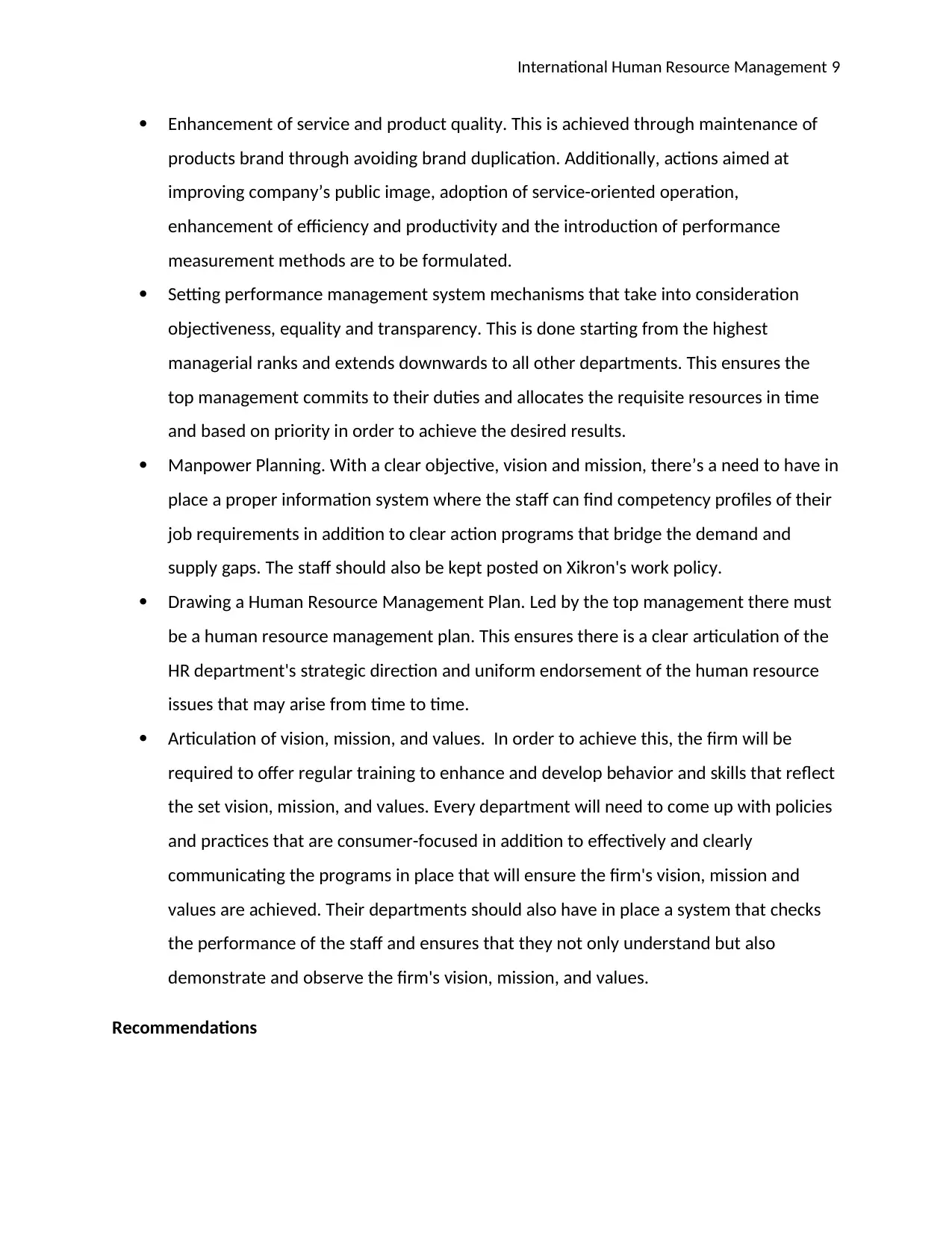
International Human Resource Management 9
Enhancement of service and product quality. This is achieved through maintenance of
products brand through avoiding brand duplication. Additionally, actions aimed at
improving company’s public image, adoption of service-oriented operation,
enhancement of efficiency and productivity and the introduction of performance
measurement methods are to be formulated.
Setting performance management system mechanisms that take into consideration
objectiveness, equality and transparency. This is done starting from the highest
managerial ranks and extends downwards to all other departments. This ensures the
top management commits to their duties and allocates the requisite resources in time
and based on priority in order to achieve the desired results.
Manpower Planning. With a clear objective, vision and mission, there’s a need to have in
place a proper information system where the staff can find competency profiles of their
job requirements in addition to clear action programs that bridge the demand and
supply gaps. The staff should also be kept posted on Xikron's work policy.
Drawing a Human Resource Management Plan. Led by the top management there must
be a human resource management plan. This ensures there is a clear articulation of the
HR department's strategic direction and uniform endorsement of the human resource
issues that may arise from time to time.
Articulation of vision, mission, and values. In order to achieve this, the firm will be
required to offer regular training to enhance and develop behavior and skills that reflect
the set vision, mission, and values. Every department will need to come up with policies
and practices that are consumer-focused in addition to effectively and clearly
communicating the programs in place that will ensure the firm's vision, mission and
values are achieved. Their departments should also have in place a system that checks
the performance of the staff and ensures that they not only understand but also
demonstrate and observe the firm's vision, mission, and values.
Recommendations
Enhancement of service and product quality. This is achieved through maintenance of
products brand through avoiding brand duplication. Additionally, actions aimed at
improving company’s public image, adoption of service-oriented operation,
enhancement of efficiency and productivity and the introduction of performance
measurement methods are to be formulated.
Setting performance management system mechanisms that take into consideration
objectiveness, equality and transparency. This is done starting from the highest
managerial ranks and extends downwards to all other departments. This ensures the
top management commits to their duties and allocates the requisite resources in time
and based on priority in order to achieve the desired results.
Manpower Planning. With a clear objective, vision and mission, there’s a need to have in
place a proper information system where the staff can find competency profiles of their
job requirements in addition to clear action programs that bridge the demand and
supply gaps. The staff should also be kept posted on Xikron's work policy.
Drawing a Human Resource Management Plan. Led by the top management there must
be a human resource management plan. This ensures there is a clear articulation of the
HR department's strategic direction and uniform endorsement of the human resource
issues that may arise from time to time.
Articulation of vision, mission, and values. In order to achieve this, the firm will be
required to offer regular training to enhance and develop behavior and skills that reflect
the set vision, mission, and values. Every department will need to come up with policies
and practices that are consumer-focused in addition to effectively and clearly
communicating the programs in place that will ensure the firm's vision, mission and
values are achieved. Their departments should also have in place a system that checks
the performance of the staff and ensures that they not only understand but also
demonstrate and observe the firm's vision, mission, and values.
Recommendations
⊘ This is a preview!⊘
Do you want full access?
Subscribe today to unlock all pages.

Trusted by 1+ million students worldwide
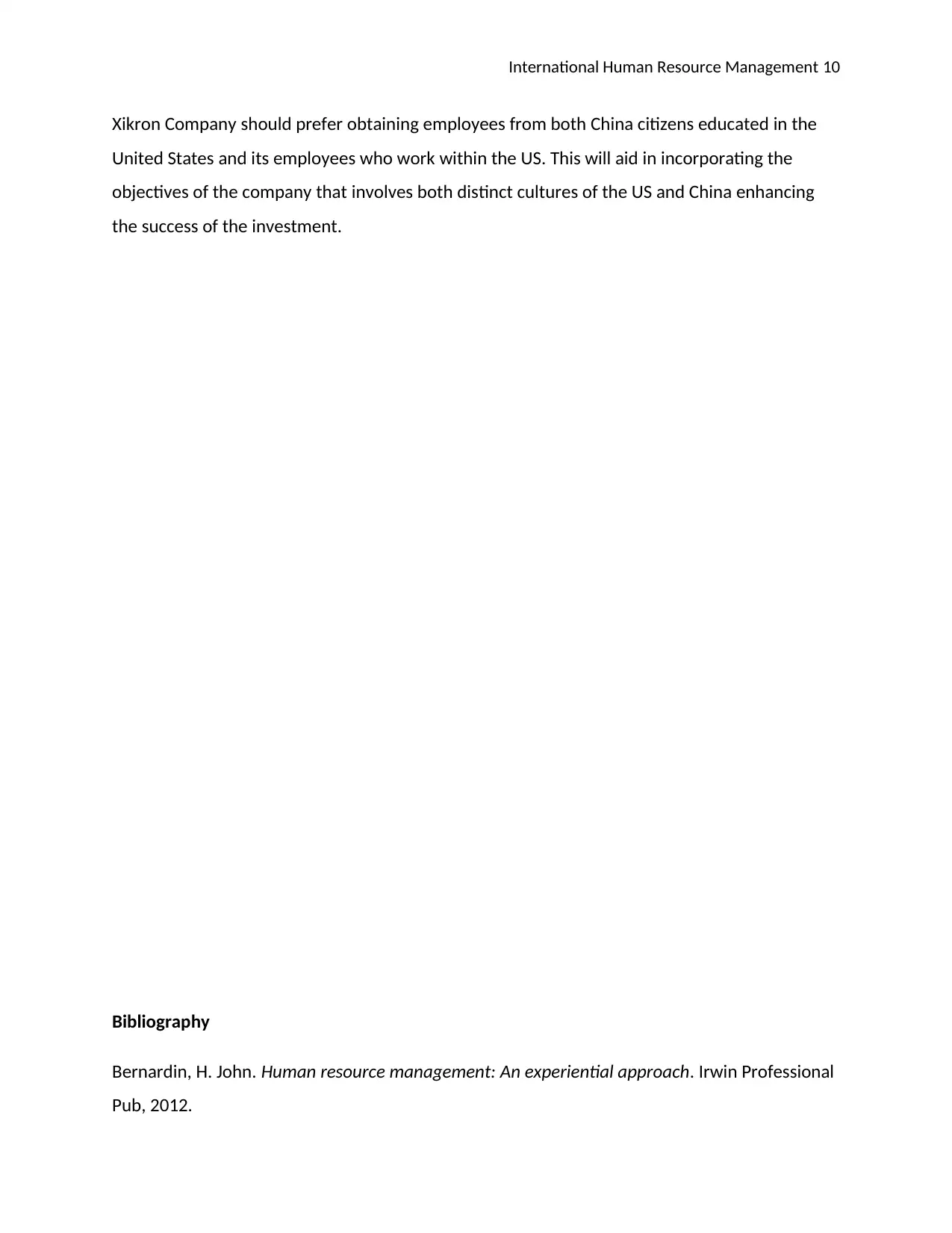
International Human Resource Management 10
Xikron Company should prefer obtaining employees from both China citizens educated in the
United States and its employees who work within the US. This will aid in incorporating the
objectives of the company that involves both distinct cultures of the US and China enhancing
the success of the investment.
Bibliography
Bernardin, H. John. Human resource management: An experiential approach. Irwin Professional
Pub, 2012.
Xikron Company should prefer obtaining employees from both China citizens educated in the
United States and its employees who work within the US. This will aid in incorporating the
objectives of the company that involves both distinct cultures of the US and China enhancing
the success of the investment.
Bibliography
Bernardin, H. John. Human resource management: An experiential approach. Irwin Professional
Pub, 2012.
Paraphrase This Document
Need a fresh take? Get an instant paraphrase of this document with our AI Paraphraser

International Human Resource Management 11
Brewster, Christopher, Elizabeth Houldsworth, Paul Sparrow, and Guy Vernon. International
human resource management. Kogan Page Publishers, 2016.
Briscoe, Dennis, Ibraiz Tarique, and Randall Schuler. International human resource
management: Policies and practices for multinational enterprises. Routledge, 2012.
Cascio, Wayne. Managing human resources. McGraw-Hill Education, 2018.
Dowling, Peter. International human resource management: Managing people in a
multinational context. Cengage Learning, 2008.
Evans, Paul, Vladimir Pucik, and Jean-Louis Barsoux. The global challenge. McGraw-Hill
Publishing Company, 2015.
Harris, Hilary, Chris Brewster, and Paul Sparrow. International human resource management.
CIPD Publishing, 2016.
Harzing, Anne-Wil, and Ashly Pinnington, eds. International human resource management.
Sage, 2010
Milliman, John, Mary Ann Von Glinow, and Maria Nathan. "Organizational life cycles and
strategic international human resource management in multinational companies: Implications
for congruence theory." Academy of management review 16, no. 2 (2011): 318-339.
Reiche, B. Sebastian, Günter K. Stahl, Mark E. Mendenhall, and Gary R. Oddou, eds. Readings
and cases in international human resource management. Taylor & Francis, 2016.
Schuler, Randall S., Pawan S. Budhwar, and Gary W. Florkowski. "International human resource
management: review and critique." International Journal of Management Reviews 4, no. 1
(2012): 41-70.
Schuler, Randall S., Peter J. Dowling, and Helen De Cieri. "An integrative framework of strategic
international human resource management." Journal of management 19, no. 2 (2012): 419-
459.
Scullion, Hugh, David G. Collings, and Patrick Gunnigle. "International human resource
management in the 21st century: Emerging themes and contemporary debates." Human
Resource management journal 17, no. 4 (2012): 309-319.
Scullion, Hugh. "International human resource management." (2010).
Brewster, Christopher, Elizabeth Houldsworth, Paul Sparrow, and Guy Vernon. International
human resource management. Kogan Page Publishers, 2016.
Briscoe, Dennis, Ibraiz Tarique, and Randall Schuler. International human resource
management: Policies and practices for multinational enterprises. Routledge, 2012.
Cascio, Wayne. Managing human resources. McGraw-Hill Education, 2018.
Dowling, Peter. International human resource management: Managing people in a
multinational context. Cengage Learning, 2008.
Evans, Paul, Vladimir Pucik, and Jean-Louis Barsoux. The global challenge. McGraw-Hill
Publishing Company, 2015.
Harris, Hilary, Chris Brewster, and Paul Sparrow. International human resource management.
CIPD Publishing, 2016.
Harzing, Anne-Wil, and Ashly Pinnington, eds. International human resource management.
Sage, 2010
Milliman, John, Mary Ann Von Glinow, and Maria Nathan. "Organizational life cycles and
strategic international human resource management in multinational companies: Implications
for congruence theory." Academy of management review 16, no. 2 (2011): 318-339.
Reiche, B. Sebastian, Günter K. Stahl, Mark E. Mendenhall, and Gary R. Oddou, eds. Readings
and cases in international human resource management. Taylor & Francis, 2016.
Schuler, Randall S., Pawan S. Budhwar, and Gary W. Florkowski. "International human resource
management: review and critique." International Journal of Management Reviews 4, no. 1
(2012): 41-70.
Schuler, Randall S., Peter J. Dowling, and Helen De Cieri. "An integrative framework of strategic
international human resource management." Journal of management 19, no. 2 (2012): 419-
459.
Scullion, Hugh, David G. Collings, and Patrick Gunnigle. "International human resource
management in the 21st century: Emerging themes and contemporary debates." Human
Resource management journal 17, no. 4 (2012): 309-319.
Scullion, Hugh. "International human resource management." (2010).
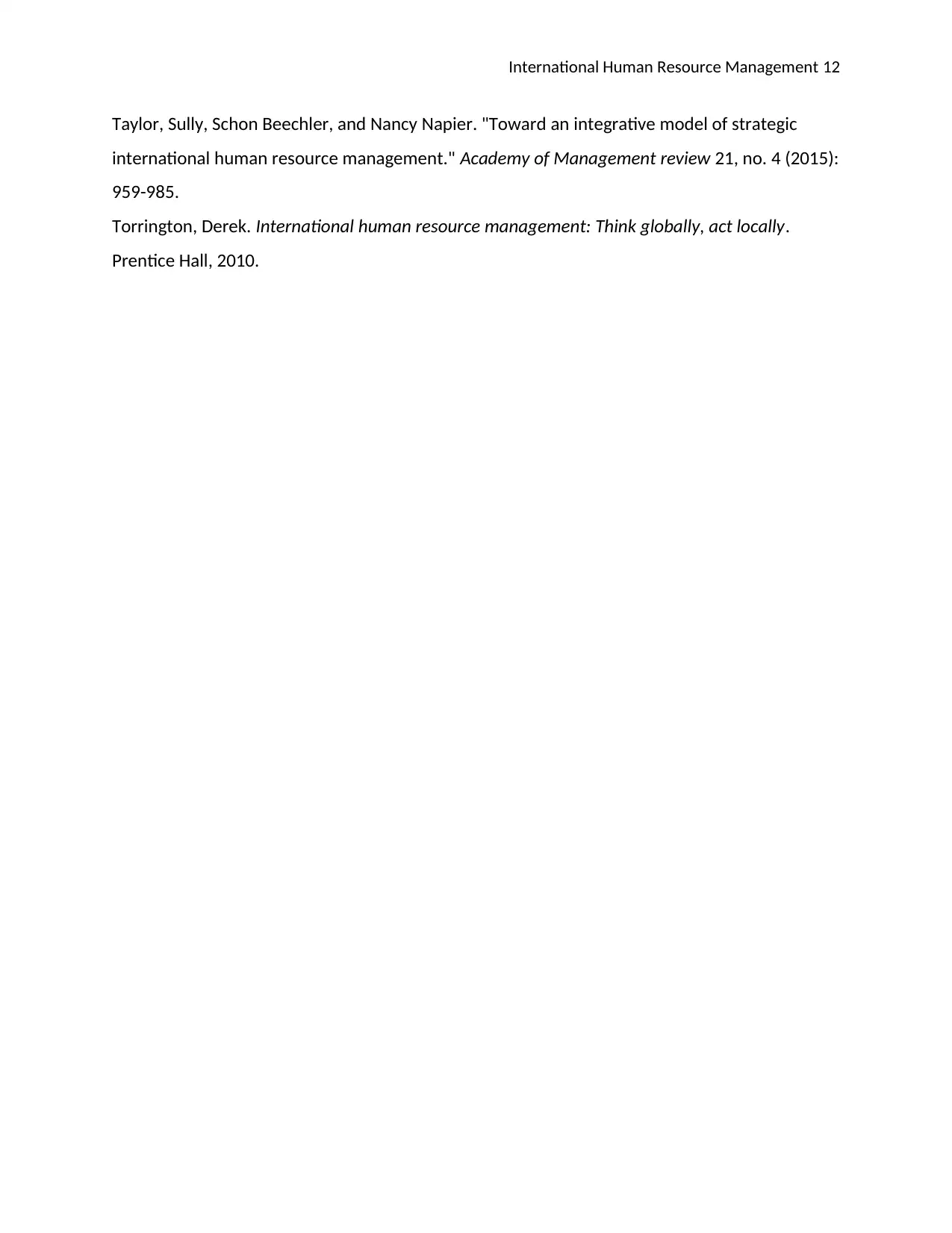
International Human Resource Management 12
Taylor, Sully, Schon Beechler, and Nancy Napier. "Toward an integrative model of strategic
international human resource management." Academy of Management review 21, no. 4 (2015):
959-985.
Torrington, Derek. International human resource management: Think globally, act locally.
Prentice Hall, 2010.
Taylor, Sully, Schon Beechler, and Nancy Napier. "Toward an integrative model of strategic
international human resource management." Academy of Management review 21, no. 4 (2015):
959-985.
Torrington, Derek. International human resource management: Think globally, act locally.
Prentice Hall, 2010.
⊘ This is a preview!⊘
Do you want full access?
Subscribe today to unlock all pages.

Trusted by 1+ million students worldwide
1 out of 12
Related Documents
Your All-in-One AI-Powered Toolkit for Academic Success.
+13062052269
info@desklib.com
Available 24*7 on WhatsApp / Email
![[object Object]](/_next/static/media/star-bottom.7253800d.svg)
Unlock your academic potential
© 2024 | Zucol Services PVT LTD | All rights reserved.





